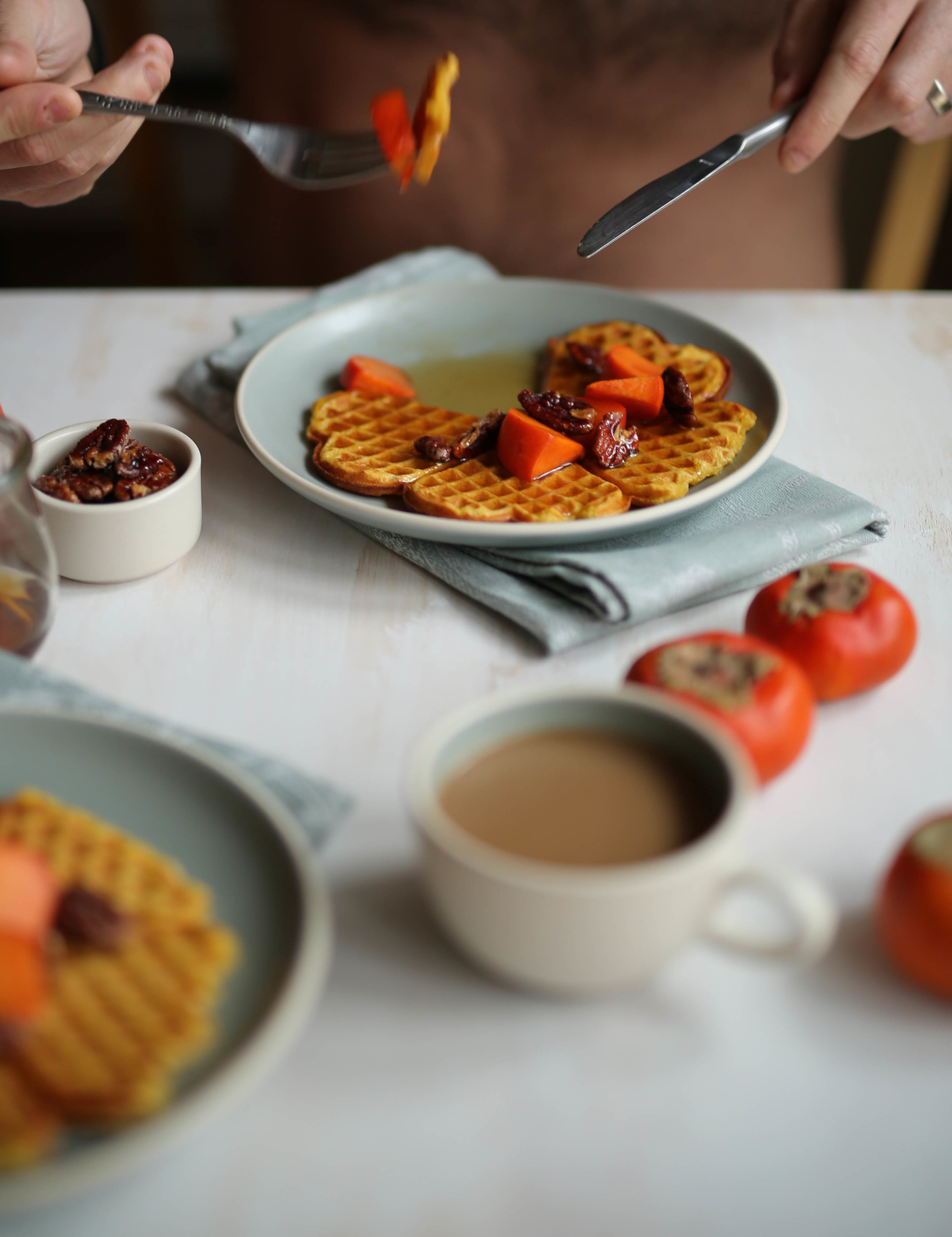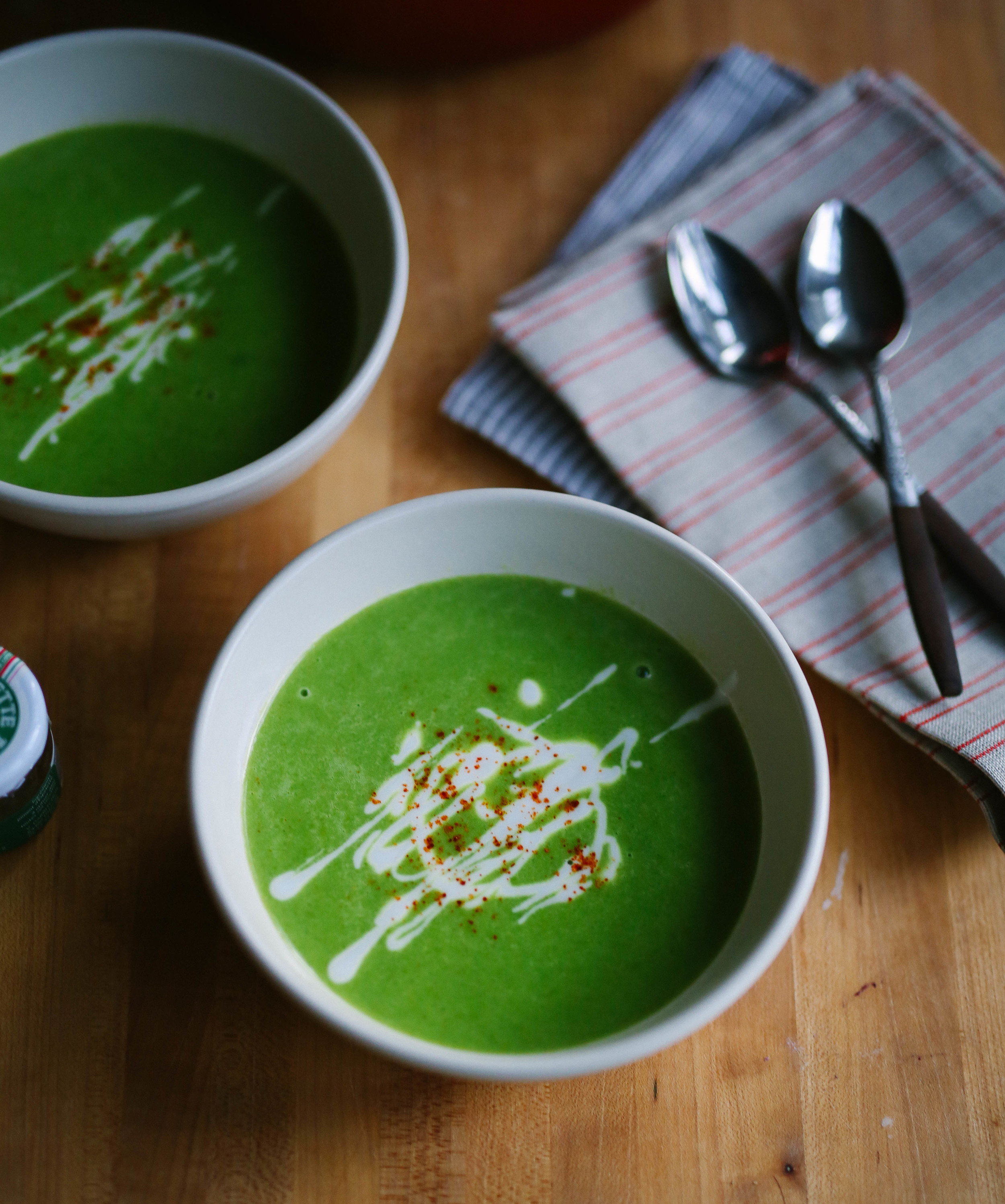It started snowing last night shortly after we went to bed. There is a narrow gap between the curtain rod and window frame in our bedroom, through which we can see the sky as we fall asleep; when it snows, occasionally a fat flake will fall in front of the sensor on porch light, startling it awake and illuminating the thousands of snowflakes slowly falling outside. I love watching the snow through my slice of a window while snuggled in bed. Having grown up on the west coast and having lived for years as an adult in a climate supportive of banana trees, I never thought I would love living in the snow, but I do, I really, really love it. I am a Pacific Northwesterner at heart, and snow is usually the closest thing we get to fog and rain in the high desert. It helps me rationalize my wintertime yearnings for baked goods, braises, and beverages served in mugs (which, to me, are not the same taken on cloudless, sunny days).
I woke up early-ish (is 10:00am on a Sunday early?) this morning and made these waffles with the persimmons that have been slowly ripening on our counter for weeks. They are reminiscent of one of Richard's mom's holiday cookie recipes, which are made with puréed persimmons mixed with cinnamon and cloves and flecked with raisins; the mounded batter bakes into tiny, delicate cakes which are best eaten straight from the oven with a tall glass of milk. These waffles, too, are spiced and have a cake-like texture that nicely bridges Richard's love of waffles with my preference for pancakes.
Persimmons are a strange fruit, and normal logic doesn't always apply when using them in recipes. While Fuyu persimmons may be eaten at any stage of ripeness (and are especially good in salads when still firm), you should only eat a hard Hachiya or American persimmon if you are looking for an in-depth experience in astringency. It is when they look their worst that they are at their best, and their wrinkly skin hides flesh so sugar saturated that it has the translucence and sheen of warm apricot jam. Ripening the persimmons to this stage is called "bletting," and refers to the sweet spot in time between just-past-the-moment-when-you-think-they-are-ripe and decay, when the tannins normally present in the fruit have been almost completely replaced by sugars. If you barely poked one of the persimmons I used with your finger, you would have left a permanent dent in its surface. You can leave hard persimmons on your counter to ripen; it may take anywhere from a few days to two weeks, so I would imagine that you could use pumpkin purée in their place in this recipe should you need instant waffle gratification.
Side note: Wikipedia has a fascinating paragraph about unripened persimmons, which will make you more comfortable with consuming both the off-looking fruit and Coca-cola; neat!
Persimmon and Spelt Waffles
adapted from Betty Rosbottom's buttermilk waffle recipe
1 cup all-purpose flour or gluten-free all-purpose flour blend
3/4 cup spelt flour or whole wheat flour
4 teaspoons sugar
2 teaspoons baking powder
1/4 teaspoon salt
1 teaspoon ground cinnamon
generous 1/4 teaspoon ground cloves
2 large eggs, at room temperature
2 ripe Hachiya persimmons Milk (whole cow's milk or nut milk)
1/2 teaspoon vanilla
6 tablespoons unsalted butter, melted and slightly cooled (v option: replace with coconut oil)
Preheat a waffle iron; if you plan to make all of the waffles before serving time, preheat your oven to 200˚F.
In a medium bowl, stir together the flour, sugar, baking powder, salt, cinnamon, and cloves. In a large bowl, whisk the eggs to break up the yolks and the whites. Set both bowls aside.
Peel the persimmons using your hands; if the fruits are ripe, the skins should easily come away from the flesh. Don't get too broken up about some flesh sticking to the skins, as you can gently scrape it off once the fruits have been peeled. Discard the skins, or give them to your chickens (who will loooove you). If you have an immersion blender, place the persimmon pulp into a measuring cup which holds at least two cups of liquid, and purée the mixture thoroughly. If you are using a stand blender, blend the persimmon pulp thoroughly, and pour into a measuring cup which holds at least two cups of liquid. Add enough milk (cow or plant) to the measuring cup so that you have two cups liquid in total, then pour back into the blender (or use your immersion blender) to briefly blend again.
Pour the persimmon-milk mixture into the eggs, add the vanilla and melted butter, and whisk to blend. Add the flour and spice mixture, and whisk just until the ingredients are combined and you no longer see any flour streaks.
Pour about 1/3-1/2 cup batter (depending on the size of your waffle iron) into the waffle iron, and gently spread the batter to within 1 inch from the edge. Close the cover and cook for 3-5 minutes, or until crisp and golden brown. Serve the waffles immediately, or place them in a single layer on racks in the preheated oven while you finish with the remaining batter.
Topping ideas: If you told the six-year old me that I would ever like topping my waffles with something other than straight maple syrup, I would have thought you had a bat in your attic. But these days I'm really liking the fruit/syrup or fruit/nut/syrup combinations. Keep in mind that persimmons are mild in flavor, so you'll want to use fruit that is equally mild (such as... more persimmons). The pecans were from my never-ending quest to crack the code behind this pecan recipe, but it's your call whether you choose to include something similar.














